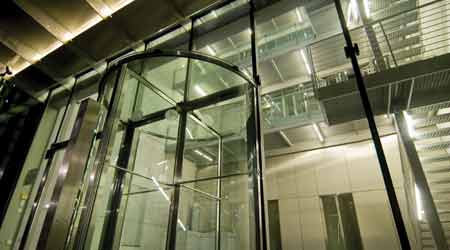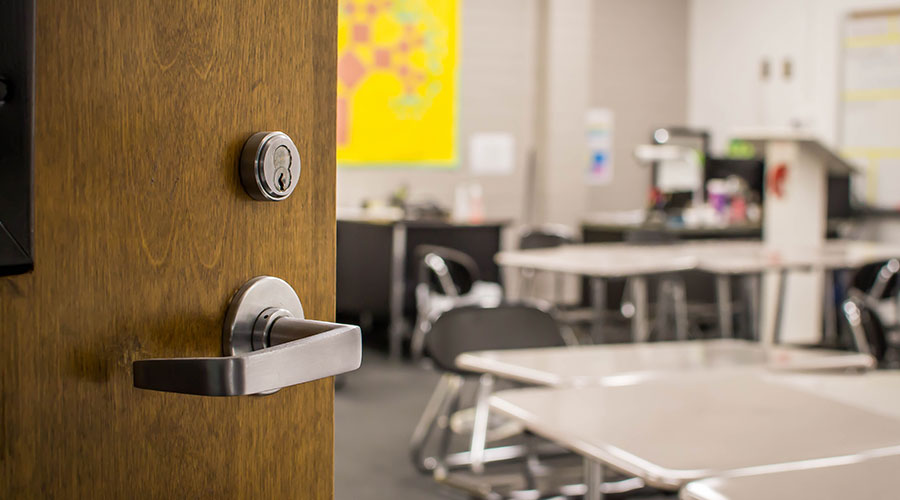 To achieve both safety and security goals, facility managers need to understand a range of factors, from traffic patterns to building codes.
To achieve both safety and security goals, facility managers need to understand a range of factors, from traffic patterns to building codes.Building Codes Determine Type of Door Hardware Installed
Facility managers must consult NFPA 80 and ADA requirements to make door and door hardware decisions.
Building codes will to a great extent determine what type of hardware can be installed where. NFPA 80 is probably the most important code requirement that must be met, but facility managers must also comply with ADA requirements and local codes as well. Code compliance can be difficult enough as it is, but the challenge is compounded by the fact that building codes are constantly changing.
Meeting the code requirements is not sufficient by itself. Facility managers must also meet the security requirements of all areas within their buildings. There will be tradeoffs to evaluate — security vs. accessibility, convenience vs. life safety, aesthetics vs. performance — all while complying with all applicable codes.
With so many factors having to be taken into consideration when selecting door hardware, and with so many options available in the market, facility managers should approach the selection process with the same level of planning used in selecting other building systems and components. The goal here is to develop a comprehensive plan that integrates a wide range of individual components in specific applications into a workable solution, one that not only meets the needs of the facility and its occupants but also one that can be maintained by operating personnel.
If there is not sufficient in-house expertise, then facility managers should seek outside assistance that is experienced in working with all of the code requirements. Not only can outside experts identify what changes may be required, but they can also help in the development of the specifications for the work necessary to bring the facility into compliance. Those specifications must be very precise if the hardware being installed is to meet all of the requirements.
After the installation
Even with careful planning, excellent designs, and a well-installed system of door hardware components, things will go wrong. Building occupants will improperly use or outright abuse the installed hardware. Dirt will foul mechanisms. Closers will go out of adjustment, causing doors to hang open or to slam shut. Doors will come out of adjustment. Door gaskets will fail. Even improperly balanced HVAC systems that overpressurize an area can prevent the proper operation of door hardware.
While there is no way to avoid all of these issues, a comprehensive maintenance program that focuses on doors will minimize their impact. The key is being proactive, not reactive. Don’t wait until an issue compromises safety or security. Identify and correct it before it can become a safety or security issue. Identify it early through regular inspections.
NFPA 80 requires an annual fire door inspection in all commercial buildings to help ensure that the facilities are in compliance with code requirements and that the doors will function as intended in the event of an emergency. Annual inspections will also identify where modification have been made to those doors and their hardware, modification that are a violation of building and fire codes.
Annual inspections, however, should be considered to be the absolute minimum effort. Doors that are considered to be critical in terms of fire safety and safe egress or those that serve high traffic areas will require more frequent inspections. And while fire door inspections address issues of safety, they do not consider security.
In addition to the inspection of fire doors, it will be necessary to inspect the operation of all door hardware in any area where security is an issue. Again, annual inspections should be considered to be the absolute minimum. Depending on the level of security needed, monthly, weekly, and even daily inspections may be required.
Finally, facility managers should make building occupants and maintenance personnel aware of how seemingly innocent steps can compromise the safety and security of a facility. For example, it is not uncommon to find internal fire doors propped open to ease passage from one portion of the building to another. But internal fire doors are there for a reason. In the event of a fire, they are designed to break the building into a number of different zones or compartments, thus limiting the spread of smoke and fire.
Another common problem found in buildings is that occupants have stored materials or furniture in corridors leading to exits. Even corridors that are only partially blocked will slow egress in the case of an emergency.
Again, regular inspections can identify areas where these and other safety issues exist. Regular notices to building occupants will help, especially if accompanied by the threat that the items will be removed.
James Piper, PhD, PE, is a writer and consultant who has more than 35 years of experience in facilities management. He is a contributing editor for Building Operating Management.
Email comments and questions to edward.sullivan@tradepress.com.
Related Topics:













